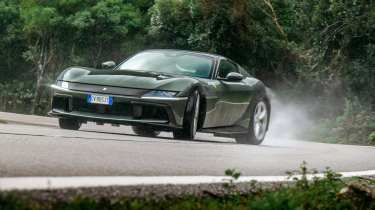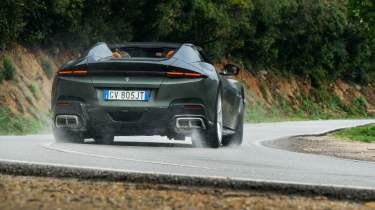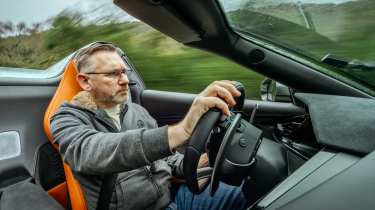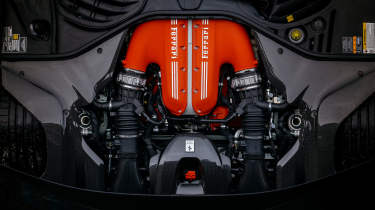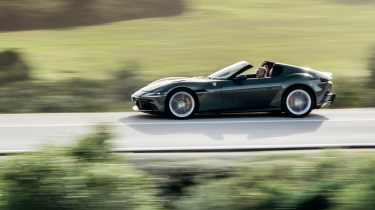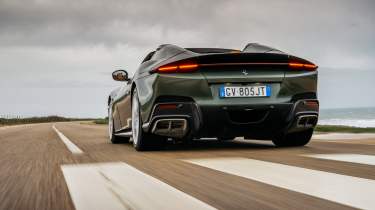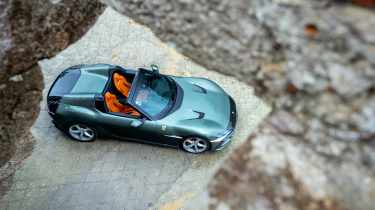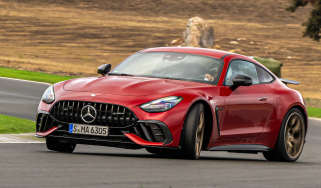Ferrari 12 Cilindri Spider 2025 review – 819bhp V12 GT goes open-air
The Ferrari 12 Cilindri is a stunning super GT offering in standard coupe form, and it's just as good without a roof
We’re not usually stoked for convertible versions of supercars because they are generally heavier and less stiff but also because travelling at high speeds in open top cars is often plain uncomfortable. However, the Spider version of the new 12 Cilindri might be the one to have.
If you’ve followed coverage of the berlinetta 12 Cilindri, you probably know why. Ferrari has worked hard to bring the 12 Cilindri to market without hybridisation and keeping all 819bhp of the naturally aspirated, 6.5-litre V12 intact while being fully compliant with global emission and noise regulations. A laudable achievement. Yet despite being named in celebration of its wonderful engine, the result was a bit Roosevelt, that’s to say ‘speak softly and carry a big stick’, because the potent 12 Cilindri didn’t have much of a voice. With the Spider’s retractable hard top we might get to hear more of it.
> Ferrari 12 Cilindri 2025 review – 819bhp super GT tested on road and track
The Spider on display at the press conference was the first 12 Cilindri I’d seen in the metal. In metallic red and on busy wheels the fussier roof seemed to draw out fussiness elsewhere, particularly around the rear diffuser and exhausts. I thought it had the look of a Ferrari one-off. In contrast, all the test cars were in dark green, which sounded like a poor choice given the storm that was forecast to roll in, but on simpler wheels and with the colour blending with the dark bands that are a feature of the design, it looked much more cohesive and attractive, with hints of 456 and SP Monza as well as the obvious nod to the Daytona.
More reviews
Ferrari talked about considering a full soft top, like the very rare Daytona Spider, but a version of the folding hardtop from the 812 GTS was always favourite. The Spider emulates that model’s 14 second stow time (at up to 28mph) and also has a small screen between the buttresses that can be dropped with the roof up. There’s a boot instead of the berlinetta’s hatchback, with luggage space down from 270 to 220 litres but usefully square.
Much effort has gone into sustaining torsional rigidity, with beefed up sills and a much strengthened A-pillar design to deliver a much stronger windscreen frame. Rear-view mirror shake is eliminated, Ferrari says. We’ll be able to check because having launched the berlinetta on Luxembourg’s unhelpfully smooth roads, we’re in southern Portugal to drive the Spider, with the threat of rain and promise of some dreadful asphalt – both soon to be realised – making us Brits feel right at home.
After a quick but invaluable in-cockpit briefing, crucially revealing how to turn off lane keep assist and adjust the bolster hug of the seats, we’re off. The V12 starts modestly and stays in the background as we make our way through the urban sprawl towards Lisbon. Initial impressions are that there’s been a welcome de-escalation of intensity. I’ve not driven the berlinetta but the Spider’s steering is not as bright as it is in some cars from Ferrari's recent past which instantly translated small inputs into an urgent request for agility.
The more Spider’s progressive steering compliments the ride which has a welcome suppleness. These roads really aren't great, with plenty of potholes, raised manholes and speed bumps too, but the chassis takes the sting out of most of it. There is some detail to the ride, it's not limo like, but it deals with the big stuff in a grown up sort of way that feels just right. The structural integrity of the Spider permits similar suspension settings to the berilinetta with semi-active, MagneRide dampers, while half decent sidewalls on the 21in tyres - 275/35 front, 315/35 rear – help too. They’re either Goodyear or, as here, Michelin. And, yes, the Spider feels solid, with no mirror shake.
The brakes are really good too; there's a lovely, tactile feel right from the top of the pedal that grows to a reassuring sense of power and progression as you get into the meat of the travel. This is especially impressive given that these are the first drive-by-wire brakes Ferrari has put into production.
The 812 Superfast was quite intense, the 812 Competizione even more so, but the 12 Cilindri, which effectively uses the Competizione’s engine, feels more GT than hypercar, and so far it’s a better car for that, and it’s a demeanour that seems particularly apt for a Spider. The disconnect is the sound of the V12. Roof up, rain falling, it’s so quiet and so well mannered, and the eight-speed gearbox shuffles smoothly into high gears to readily, that you can almost forget the huge performance potential under you right foot.
Curious, waiting at a set of lights I turn the manettino all the way round to CT off and on the green light floor it. Almost instantly the rear tyres spin up and we head up the road with a twist of opposite lock and the V12 hitting the 9500rpm rev limiter. Brutal but beautiful, yet still no great voice. I’m looking forward to getting the roof stowed but I’m not convinced it’s going to uncork the noise. Drop the window between the buttresses and there's a bit more detail to the tailpipe noise but it's still quite subdued.
With Lisbon an hour behind us, we’ve out-run the storm and the roof disappears beneath the rear deck. As I suspected, it’s not transformative. From low revs there’s a bit of delicious V12 timbre, a classy, complex churn, but thereafter mostly it's in the background. It's simply not a vocal engine, certainly not as rousing and bass heavy as the V12 in its obvious rival, the new Aston Martin Vanquish. I’m not sure how Aston does it with turbos which are meant to dampen intake noise. Ferrari says the 12 Cilindri has resonators ahead of the throttle body inlets to take sound directly from engine and transmit it into the cockpit but it doesn't really come across.
When you see somebody go by in a 12 Cilindri it looks like they're almost sitting on the rear axle but you're not aware of that from the driver's seat. The ride is good and the car feels poised and agile. There is rear-wheel steering – the rear wheels can toe in to help stability under braking and be steered individually to help in certain scenarios – and when you make a steering input, you feel that the rear is as much a part of turning the car as the steering wheel. Yet while there is quite a lot of rotation in the car and it initially feels a little synthetic, after a few miles you start to get used to it and it certainly helps disguise the mass.
The Spider weighs 60kg more than the Berlinetta, 1620kg dry ‘with optional lightweight content’ – ie with all the carbon options it’s possible to specify. What’s impressive is how far back the mass of the V12 is, the whole engine sitting aft of the front axle line, so most of the mass is inside the wheelbase, which is a couple of centimeters shorter than the 812’s. The weight distribution shifts fractionally further rearward, from the coupe’s 48/52 front/rear to 47.8/52.2, a ratio that surely becomes a little more rear-biased again when you hit the button and the two-part aluminium roof folds itself into the space beneath the buttresses.
Threading such a wide car along narrow, wet roads with over 800 horsepower under you right foot, it helps to know where the limits are, and how well telegraphed. Grip is impressive. Push hard into a tight turn and the front will eventually wash wide, a little abruptly but the steering lets you know it’s imminent. Of course, the rear will slip if slacken off stability control and give the throttle enough of a prod, but you can get a feel for that, risk free, before you explore the more adventurous settings on the manettino.
In wet and in sport modes stability control steps in pretty early to stop slip escalating, describing how much traction you've got to work with. The throttle should be linear and the drive direct, delivering predictable, consistent drive; it's a naturally aspirated engine paired with a dual-clutch gearbox, after all, and so it proves. There’s always an element of stepping into the unknown, of course.
With CT off, a couple of heavy-footed runs through the same, slick wet corner reveal a helpfully benign response from the rear. You stab the throttle, the car kicks sideways and then you're off the throttle a bit and quickly winding on the opposite lock, then ready to manage the bounce back. However, the fat Michelins recover grip much more smoothly than expected. The 12 Cilindri has a six-axis dynamic controller that can coordinate rear-wheel steering, brake by wire and the torque vectoring diff, and it feels like there is some help forthcoming, even with stability control turned off.
Employ some subtlety, use a measured, part-throttle prod on the entry and the Michelins will unhook sweetly, the rear will glide gently out to a useful angle, caught with a calm handful of opposite lock, and then at the corner exit the Michelins come sweetly back into line as you get the steering straight. Very smooth, very neat, very repeatable.
Of course, you can leave the traction and stability control on, delegate responsibility to the car and exploit as much performance as can be used in the wet, but I always feel better placed to drive a car quickly in the dry if I’ve explored its limits in the wet. By mid-afternoon the sun has dried the roads that opportunity arises. The difference is extraordinary; I’m literally gob-smacked. The amount of traction, the level of grip and the corner speed the 12 Cilindri can carry is so far beyond what you have in the wet it's staggering. The chassis still has that inherent agility but leaning on what feels like four-times the grip, it whips through corners in a very composed manner, every ounce of the mighty V12’s energy transmitted to the road.
Flat out, the 12 Cilindri is one of those cars that feels properly quick in first and second, but you’re kind of expecting that. It’s when it get into third that the crazy seems to escalate. You’re travelling at a lick by now and so expect the rate of acceleration to start tailing off but instead it seems to get stronger. Then you take fourth and it feels like the performance has increased again, the scenery blurring either side, the road getting narrower and the next crest arriving like a pull-focus movie shot. It’s astonishing.
Ferrari talks about torque shaping in third and fourth giving a more linear throttle response and maybe that’s a factor but I think it’s a sensation that can only be delivered by big horsepower cars and comes from the fact they have the muscle to shrug off aerodynamic drag and rolling resistance and pin you into your seat up to much higher speeds.
Thing is, how many times you get to do that? In the UK, third gear takes you well over the limit. And that's the rub with the 12 Cilindri: you want to be entertained when you're not going for it, and a great engine note does that. Even with the roof stowed and all windows down and the V12 is hauling hard in the mid-range, the Ferrari V12 is not engagingly, entertainingly vocal. It’s a great mover with the soundtrack turned down. There’s a little of the V12 growl you crave at low revs, a bit of the bark at very high revs too but in between it’s simply too quiet, too refined. The loudest noise you hear is a crack from the tailpipes at maximum rev upshifts and that’s no substitute.
The Spider is a remarkably capable front-engined supercar and a very good GT too, with an easy-going drivability and supple ride. Roof up, I’d guess it’s pretty much as refined as the berlinetta, and structurally it was solid over some dreadful surfaces. It’s not the last word in smoothness the gearbox is generally very good but in slow traffic, on and off of the throttle, it can be a little bumpy. Same goes for the brakes, which are superb everywhere else, but a little tricky to finesse using very light, subtle pedal inputs.
We had trouble deciding how refined the Spider was in terms of wind noise and buffeting, roof down at speed, because by the time we were on the highway heading back to Lisbon, we ran into the high winds of the storm we’d spent the day dodging. That said, the only thing you seem to be missing out on going for the Spider rather than the berlinetta, is the coupe’s dramatic styling.
12 Cilindri or Vanquish? I think both tread the line between supercar thrills and GT usability quite brilliantly. It comes down to sound. If you’ve got an 800bhp V12, you want to hear it as well as feel it, and there’s not enough feedback in the Ferrari. If you’ve got one of world’s most amazing engines, a 6.5-litre, naturally aspirated V12 that revs to 9500rpm, that’s worth shouting about.
Ferrari 12 Cilindri Spider specs
| Engine | V12, 6496cc |
| Power | 819bhp @ 9250rpm |
| Torque | 500lb ft @ 7250rpm |
| Weight | 1620kg (dry) (514bhp/ton) |
| Tyres as tested | Michelin Pilot Sport S 5 |
| 0-62mph | 3.0sec |
| Top speed | 211mph+ |
| Basic price | £366,500 |

